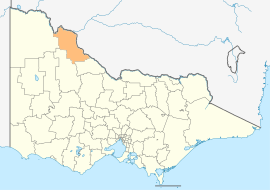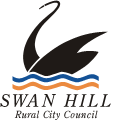Rural City of Swan Hill
|
Rural City of Swan Hill Victoria |
|||||||||||||
|---|---|---|---|---|---|---|---|---|---|---|---|---|---|

Location in Victoria
|
|||||||||||||
| Population | 20,409 (2015 est) | ||||||||||||
| • Density | 3.3364/km2 (8.6413/sq mi) | ||||||||||||
| Established | 1995 | ||||||||||||
| Gazetted | 20 January 1995 | ||||||||||||
| Area | 6,117 km2 (2,361.8 sq mi) | ||||||||||||
| Mayor | Cr Les McPhee | ||||||||||||
| Council seat | Swan Hill | ||||||||||||
| Region | Northern Victoria | ||||||||||||
| State electorate(s) | |||||||||||||
| Federal Division(s) | Mallee | ||||||||||||
 |
|||||||||||||
| Website | Rural City of Swan Hill | ||||||||||||
|
|||||||||||||
The Rural City of Swan Hill is a local government area in Victoria, Australia, located in the north-western part of the state. It covers an area of 6,117 square kilometres (2,362 sq mi) and, at the 2011 Census, had a population of 20,449. It includes the towns of Swan Hill, Lake Boga, Manangatang, Nyah, Nyah West, Piangil, Robinvale, Ultima and Woorinen South. It was formed in 1995 from the amalgamation of the City of Swan Hill, Shire of Swan Hill and part of the Shire of Kerang.
The Rural City is governed and administered by the Swan Hill Rural City Council; its seat of local government and administrative centre is located at the council headquarters in Swan Hill, it also has a service centre located in Robinvale. The Rural City is named after the main urban settlement lying in the south-east of the LGA, that is Swan Hill, which is also the LGA's most populous urban centre with a population of 10,431.
The council is composed of four wards and seven councillors, with four councillors elected to represent the Central Ward and one councillor per remaining ward elected to represent each of the other wards.
The council meets in the council chambers at the council headquarters in the Swan Hill Municipal Offices, which is also the location of the council's administrative activities. It also provides customer services at both its administrative centre in Swan Hill, and its service centre in Robinvale.
...
Wikipedia
